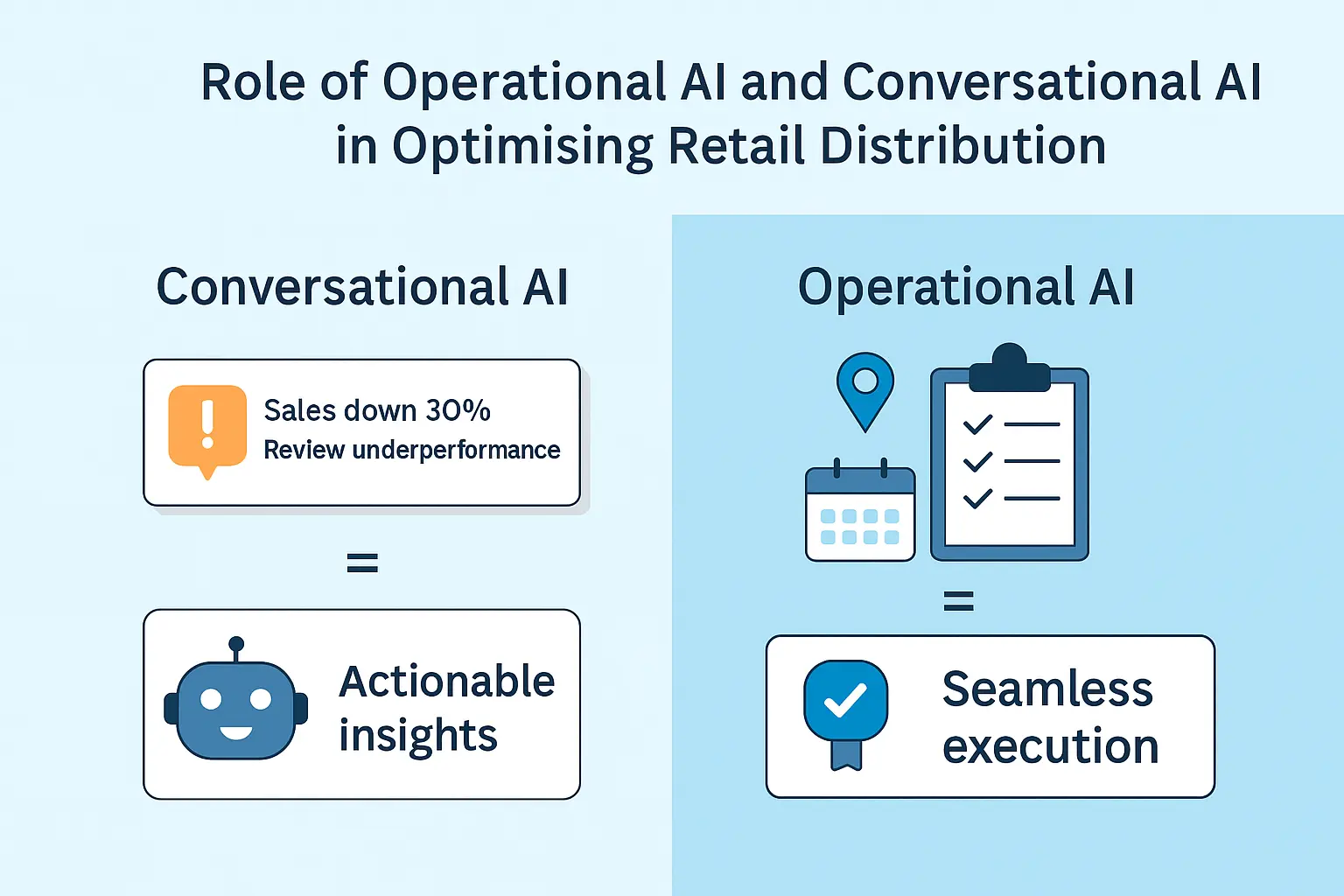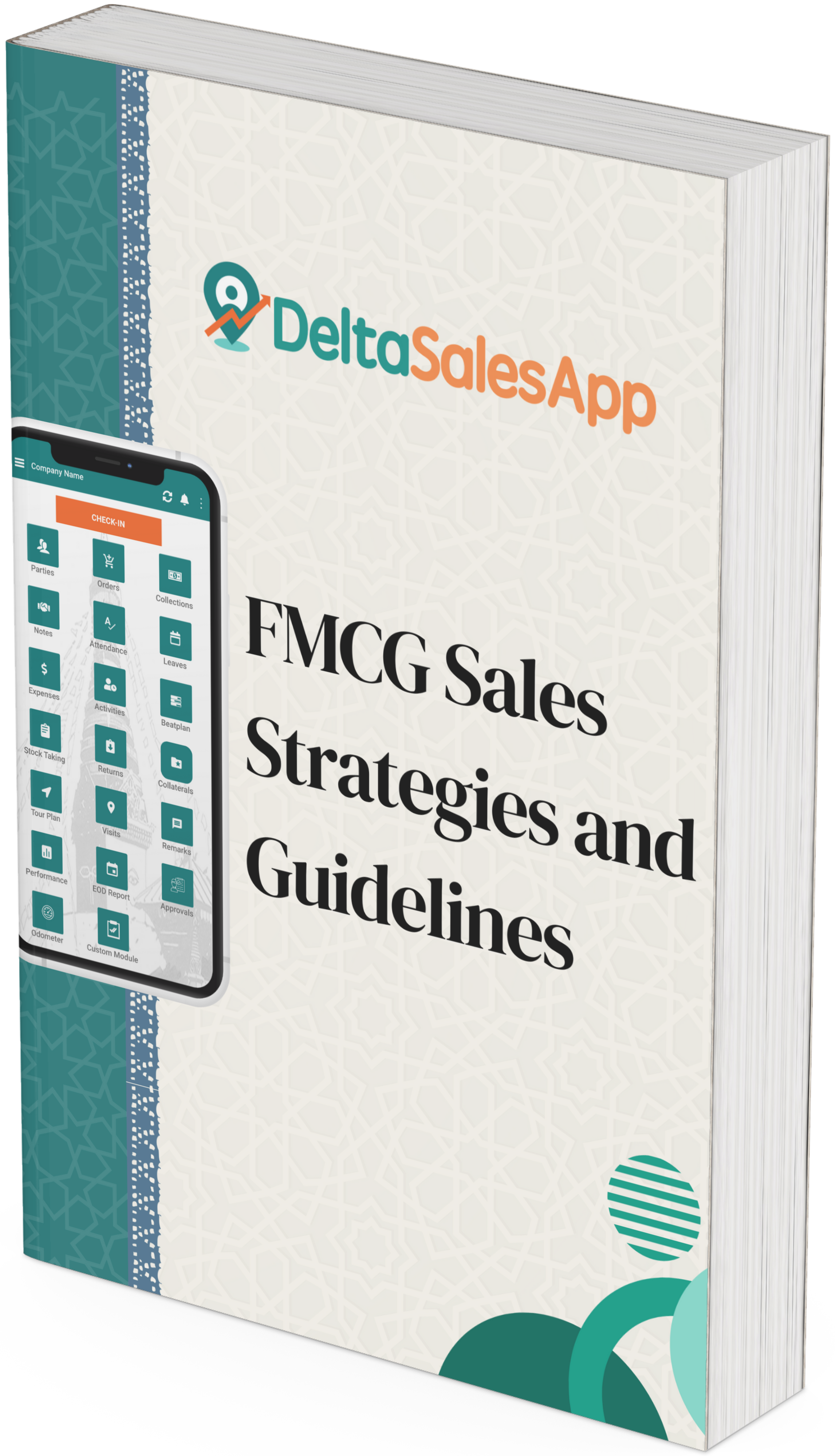How Conversational and Operational AI Are Reshaping Retail Sales Execution
_1745927570.webp)
In today’s hyper-competitive retail landscape, Artificial Intelligence (AI) is no longer optional—it’s mission-critical. Whether you're managing thousands of retail stores, optimizing field sales, or ensuring the right products are in the right locations, AI has the potential to turn routine execution into a strategic advantage.
This article breaks down the two most powerful AI models transforming retail distribution today: Operational AI and Conversational AI. We’ll explore their distinct strengths, how they complement each other, and why integrating both is the smartest move for future-ready brands across FMCG, Consumer Goods, Pharmaceuticals, and more.
What is Conversational AI in Retail?
Conversational AI enables human-like interaction with data. Through voice commands or chat interfaces, sales professionals can extract deep insights, receive real-time updates, and make strategic decisions in seconds—without ever opening a dashboard.
Core Capabilities:
Proactive Alerts: AI notifies managers about sales drops, scheme misuse, or stockouts automatically.
Smart Querying: Ask questions like “Which outlets didn’t place an order this week?” and receive immediate answers.
Simplified Analytics: Replace dashboards with real-time, conversational insights.
Use Cases:
Territory sales managers asking for insights mid-field visit.
Sales directors identifying underperforming areas before reviews.
Reps receiving automated nudges to follow up with missed retailers.
What is Operational AI in Retail?
Operational AI is designed to automate and optimize the execution side of sales. From smart beat planning to stock recommendations, it helps field teams and distribution heads implement strategies with precision.
Core Capabilities:
Dynamic Visit Planning: AI prioritizes which stores to visit based on real-time risk and opportunity.
Intelligent Order Suggestions: Suggests SKUs based on past purchases and stock trends.
Customer 360 Profiles: Aggregates insights across channels for personalized in-store conversations.
Use Cases:
Planning optimal daily sales routes.
Suggesting top-up orders for frequently missed SKUs.
Identifying stores with declining trends before it’s too late.

Sales Enablement App: Turning Strategy Into Field Action
A sales enablement app isn’t just about showing data to your team. It’s about turning that data into daily, goal-oriented action on the ground. Sales enablement platforms that use AI allow reps to:
Access contextual sales goals for each visit
Automatically receive product push alerts based on schemes and promotions
Get trained on new SKUs or route priorities through bite-sized, in-app content
With integrated AI, these tools don't just guide reps—they coach them in real-time, turning average performers into top contributors.
Example: A manager gets alerted about a scheme underutilization in Zone B. Using the sales enablement app, they assign learning tasks and execution goals to relevant reps instantly.
Van Sales Management App: AI for the Moving Storefront
Van sales operations face unique challenges: mobile stock tracking, real-time invoicing, and on-the-spot order capture. An AI-powered van sales management app solves these by integrating:
Live inventory updates inside vans
Order recommendations based on customer buying history at each stop
Optimized route planning for daily delivery and sales efficiency
AI enables the van to act like a smart retail node—helping maximize sales while reducing waste, missed opportunities, or stock misalignment.
Example: As a sales rep visits retail points in a mobile van, the system highlights which products to upsell and flags customers who’ve not ordered recently.
Territory Management App: Precision at Scale
Territory management is more than just assigning reps to areas. With AI, it becomes a dynamic engine that continuously adapts based on real-time performance and customer behavior.
An intelligent territory management app does the following:
Identifies geographic sales potential using heatmaps and growth indicators
Dynamically reassigns outlets or reps based on territory performance
Supports hyper-local campaigns driven by data
This helps companies scale faster, rebalance workloads fairly, and uncover hidden growth in overlooked micro-markets.
Example: The app detects a cluster of inactive retailers in a growing suburb and suggests shifting additional rep focus to unlock growth.
Operational AI vs Conversational AI: How They Work Together
| Feature | Operational AI | Conversational AI |
|---|---|---|
| Primary Goal | Execute daily tasks efficiently | Extract and act on insights instantly |
| Best For | Sales reps, channel partners | Managers, analysts, decision-makers |
| Example Use | Recommend visit routes and SKUs | Ask “Why are sales down in Zone 3?” |
| Business Impact | Reduces inefficiencies, optimizes planning | Enables real-time strategy adjustments |
Why Combining Both Matters
Individually, both AIs add value. Together, they become a sales execution powerhouse.
Conversational AI identifies the problem.
Operational AI solves it in the field.
Imagine getting an alert about a sales drop in a specific area—and immediately being guided on whom to visit, what to pitch, and which SKUs are underperforming. That’s the power of combining both.
Real-World Application Across Industries
FMCG: Spot distribution gaps, push schemes smartly.
Pharmaceuticals: Monitor prescription compliance and rep performance.
Consumer Durables: Drive secondary sales through actionable store insights.
Building Materials & Auto Parts: Prioritize high-potential dealers based on seasonality and historic trends.
The Platform Advantage: Unified Sales Intelligence
Platforms combining both AI types elevate execution across the board. Teams get:
Faster decision-making with smart prompts
Smarter execution with automated plans and suggestions
Improved coverage without micromanaging field reps
The result: a field force that’s agile, informed, and goal-driven.
Conclusion: AI is the Future of Retail Sales Execution
Retail brands that combine real-time insights with intelligent execution gain a significant edge. AI isn't just about automation—it's about empowering every member of your sales team with clarity, speed, and confidence.
If you’re ready to reimagine your retail strategy with Conversational and Operational AI, explore platforms that deliver goal-driven execution, not just dashboards.
FAQ – AI in Sales Execution
Q1. What is the difference between Conversational AI and Operational AI?
Conversational AI delivers real-time, natural language insights for faster decisions, while Operational AI automates execution like route planning and order recommendations.
Q2. How does AI help in field sales?
AI helps reps prioritize store visits, improve order value, and reduce time spent on manual planning, leading to better productivity and coverage.
Q3. How does a sales enablement app work with AI?
An AI-powered sales enablement app guides reps with smart goals, real-time product suggestions, and training prompts to improve field performance on the go.
Q4. Can AI be used in van sales operations?
Yes. An AI-driven van sales app supports route planning, mobile stock management, and on-the-spot order suggestions to improve efficiency and boost sales.
Q5. What does a territory management app powered by AI offer?
It optimizes territory coverage by dynamically assigning reps, identifying underperforming zones, and enabling localized campaign execution with real-time feedback.
Explore more
👉AI and Retail Execution Key Insights on Transforming Retail with AI
👉Transitioning From Traditional To AI-Driven Field Service Management Software
See What Users Say About Us!
Delta Sales App, trusted by businesses for streamlining sales processes and boosting productivity, is highly rated on top review platforms.
See what real users have to say about us:









